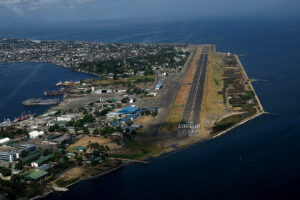Sangley Point’s development into the Sangley Point International Airport (SPIA) remains a topic of debate. Despite the project’s recent approval by the Philippine Competition Commission, the Department of Transportation (DoTr) has yet to receive detailed plans for the proposed development.
Transportation Undersecretary Roberto C.O. Lim, as quoted by BusinessWorld, confirmed that while the project remains in its early stages, it still requires various clearances including an Environmental Compliance Certificate (ECC) and approval from the Philippine Reclamation Authority. Now, I believe, is the time to rethink the purpose of Sangley’s development.
For decades, the government eyed Sangley Point as a potential solution to the congestion at Ninoy Aquino International Airport (NAIA). In 2019, the government allowed Sangley Point’s use for general aviation and smaller aircraft to relieve NAIA. Sangley offers an alternative runway to NAIA’s two runways.
Yet, despite its operational history and unique location, Sangley’s transformation into a full-fledged international airport might not be the best solution — especially in light of ongoing airport development elsewhere. Instead, I believe Sangley Point may hold far greater potential as a logistics hub and freeport, an economic zone akin to Subic Bay or Clark, where its strategic value could be maximized.
At first glance, an additional international airport seems like a sound idea for decongesting NAIA, especially with its reputation for delays and inefficiency. However, the reality is more complex. Just last month, NAIA’s operation was turned over to the private sector group that has won the bid to rehabilitate and modernize the airport complex.
Moreover, the ongoing development of the Bulacan International Airport is also addressing the need for a new, larger airport to serve the growing demands of the greater Manila area. Additionally, the expansion of Clark International Airport, which has seen recent upgrades in both capacity and infrastructure, provides an alternative that is well-positioned to serve Central and Northern Luzon.
In short, Bulacan and Clark, along with NAIA’s modernization plan, make the necessity of a new international airport in Cavite questionable.
As BusinessWorld quoted transportation expert Rene S. Santiago, airports are “agglomerative” by nature. Instead of distributing traffic evenly across multiple locations, airports tend to draw passengers and logistics to a central hub. Given the geographical proximity of NAIA, Clark, and the upcoming Bulacan airport, adding Sangley into the mix could result in redundant infrastructure.
Sangley’s viability as a commercial international airport would depend on major investments, such as an expressway connecting it to Manila — a project that would require billions of pesos and years to complete. Furthermore, closing NAIA, as some have suggested, is not a feasible option in the near term.
Rather than focusing on passenger air traffic, Sangley’s strategic location and history as a military base make it an ideal candidate for redevelopment as a logistics hub and freeport. Senator Bong Revilla, in 2019, proposed a bill that suggested converting Sangley Point into a logistics hub, similar to the transformation of Subic Bay and Clark into thriving economic zones.
Both Subic and Clark, once US military bases, have since become essential to the country’s logistics network, hosting foreign and local businesses while still maintaining military presence. Subic’s success, for instance, lies not in its role as a passenger airport but as a commercial port and freeport zone, facilitating trade and investment. Its deep-water harbor is essential for international shipping, making it a gateway for imported and exported goods.
Sangley could follow a similar trajectory. Its proximity to Metro Manila, the Cavite Export Processing Zone (CEPZ), and the Calabarzon industrial belt makes it a natural choice for businesses needing efficient access to air, sea, and land transportation networks.
Moreover, the transformation of Clark International Airport into a multi-use zone further demonstrates the benefits of converting military bases into logistics hubs. Clark, while accommodating passenger flights, has become a critical part of the country’s aviation and logistics infrastructure. FedEx, which used to operate in Subic, has established its Asia-Pacific hub in Clark, underscoring the potential for Sangley to attract similar investments.
One of the key advantages of developing Sangley as a logistics hub is the possibility of maintaining both military and commercial operations simultaneously. Sangley’s history as a military base is an asset rather than a hindrance to its future. The Philippine Navy and Air Force continue to use parts of Sangley Point, just as they do in Subic and Clark. In fact, joint military-commercial operations are common across the globe, allowing for the coexistence of defense and commerce in strategic areas.
For instance, Subic’s port continues to service naval vessels, while its freeport zone hosts manufacturing and logistics companies. In Cebu, Mactan-Cebu International Airport operates adjacent to an airbase, demonstrating that civilian and military operations can successfully coexist. Sangley could adopt a similar model, where military functions are retained alongside a bustling logistics hub, ensuring national security while fostering economic growth.
The global shift toward e-commerce and rapid delivery services highlights the need for efficient logistics infrastructure. With Metro Manila’s congestion only worsening, a dedicated logistics hub in Cavite could ease the burden on NAIA, which is still forced to handle both cargo and passenger flights. While NAIA serves as the country’s main international gateway, its limited runway capacity and focus on passenger traffic mean that it struggles to keep up with cargo demands.
Sangley’s development as a logistics hub would fill this gap, offering a dedicated space for air freight while freeing up NAIA for passenger operations. Cavite’s proximity to the major shipping lanes of the West Philippine Sea also makes it ideal for air-sea logistics integration, where goods can be quickly transferred from planes to ships and vice versa, streamlining the supply chain and reducing costs for businesses.
The potential economic benefits of converting Sangley into a logistics hub and freeport extend far beyond just decongesting airports. The Cavite Export Processing Zone is one of the country’s largest industrial hubs, and it stands to gain from having a nearby logistics center capable of handling both domestic and international shipments. Companies based in the zone would benefit from reduced transportation times and costs, making Cavite even more attractive for foreign investment.
Additionally, Sangley could serve as a hub for various industries, from electronics to automotive parts, aligning with the manufacturing base already present in the region. The development of a freeport would offer tax incentives and other benefits to attract more businesses, creating jobs and fostering economic growth in Cavite and surrounding provinces.
The experiences of Subic, Clark, and even Poro Point in La Union provide clear examples of how former military installations can be successfully repurposed into logistics hubs and economic zones. These areas have thrived not just by serving local businesses but by positioning themselves as regional centers for trade, logistics, and industry. Sangley, with its proximity to Manila and key industrial zones, is well-positioned to replicate this success.
While the idea of another international airport in Sangley may have made sense five years ago, the current landscape suggests that its best use lies in logistics and trade. Sangley’s strategic location, military history, and proximity to industrial hubs make it far more valuable as a logistics hub and freeport than as a passenger airport. By learning from Subic and Clark and Poro Point, the Philippines can turn Sangley into a critical part of its economic future — one that supports both national defense and commerce.
Marvin Tort is a former managing editor of BusinessWorld, and a former chairman of the Philippine Press Council
matort@yahoo.com

